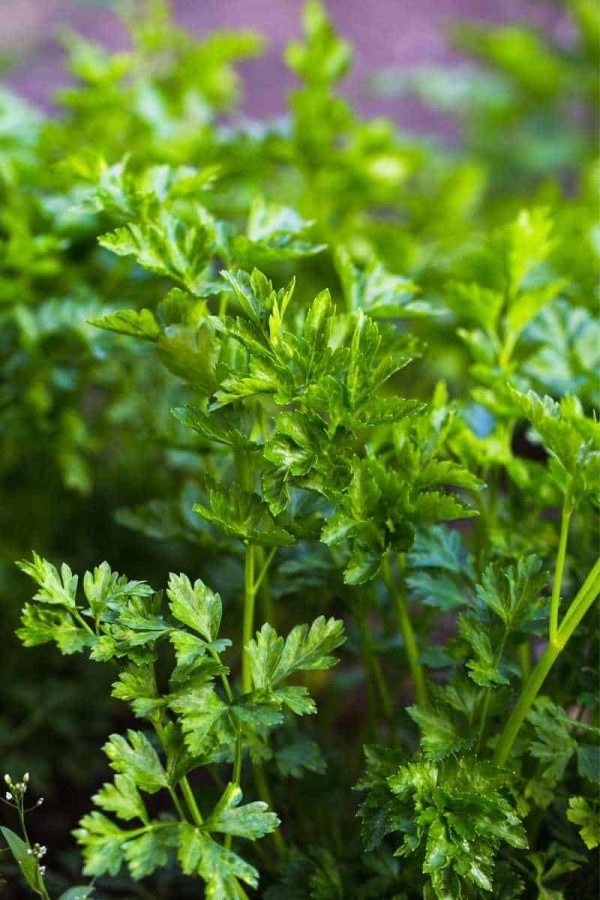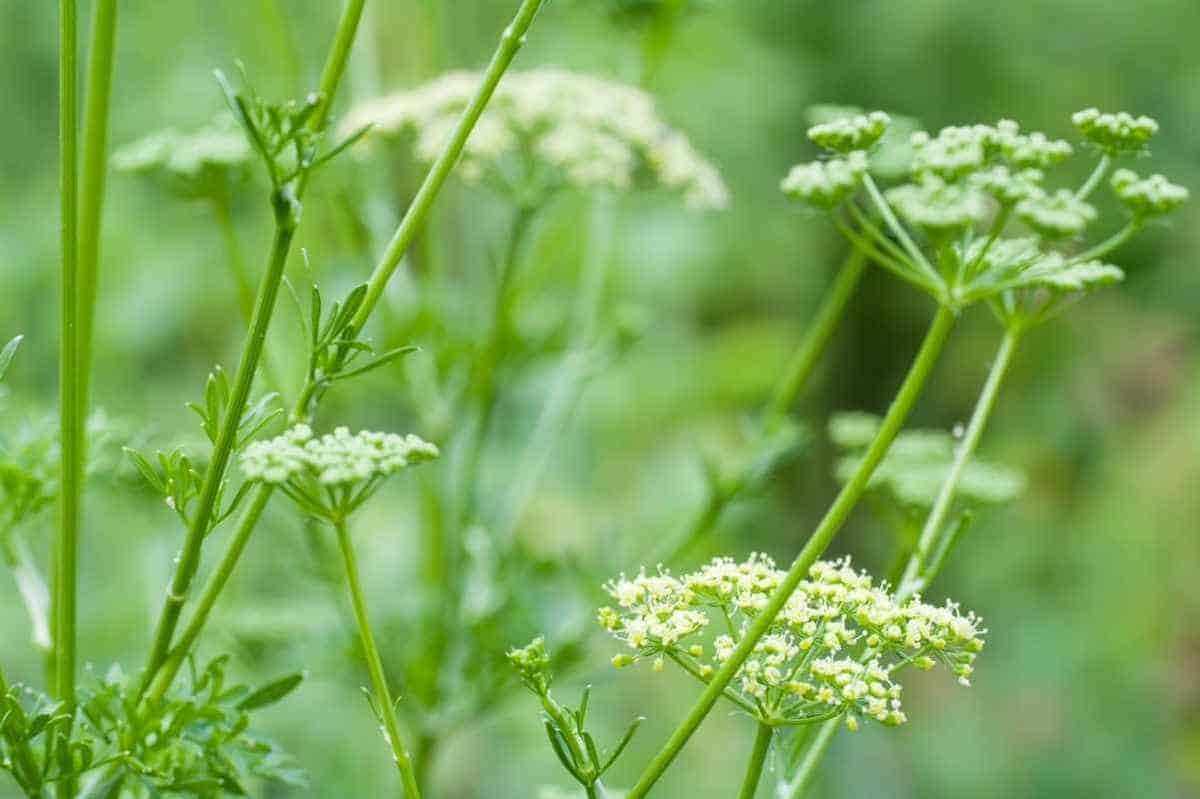Download Printable Parsley Growing Guide »
One of the most versatile herbs you can grow is parsley. It is used in numerous cuisines to add a bright, fresh flavor to soups, stews, salads, and other dishes, particularly European and Middle Eastern fares.
Even if you don’t plan on cooking with it, parsley is a great addition to your garden to help attract pollinators—the caterpillars of swallowtail butterflies love parsley! Parsley is easy to grow and super hardy. Let’s talk about how to grow parsley!

Table of Contents
Is parsley easy to grow?
Parsley is a biennial herb that can be harvested again and again. As a member of the carrot family, it grows in a similar cultural habitat to cilantro and carrots. Parsley is incredibly easy to grow. It doesn’t have any special soil or nutrient needs, and depending on your growing zone, it can be hardy to last through the majority of the fall and winter.
Should I plant parsley seeds or plants?
We’ve had good luck growing parsley from both indoor seedlings and directly sown in the garden, so the answer to this question will depend on how quickly in the spring you want to start harvesting. Giving your parsley plants a headstart indoors will get you harvesting parsley 6-8 weeks earlier than if you direct sow your seeds as soon as the soil can be worked.
Growfully Protip
Parsley’s root structure is a taproot. Taproot vegetables are typically not great candidates for transplant, but as long as you don’t let your parsley plants get too large in their seeding pots and you are careful to not disturb the roots much (we like newspaper pots, peat moss pots, or cow pots to help with this), we’ve had great luck transplanting parsley.
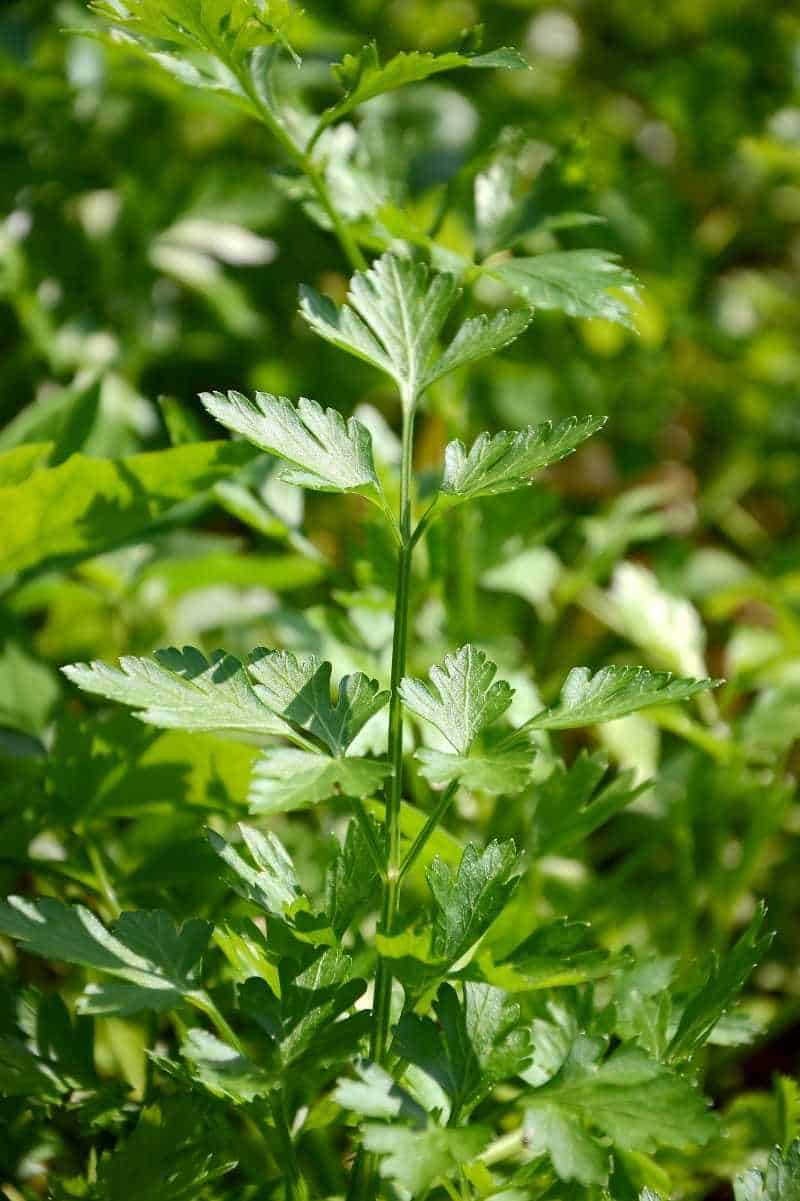
What kind of parsley should I look for?
There are two types of parsley: curly leaf parsley and flat-leaf parsley. Curly leaf parsley is most often used as a garnish, while flat-leaf parsley (often referred to as Italian parsley) is used as an ingredient in Italian and Middle Eastern dishes. However, they can generally be used interchangeably. Either work!
When do I plant parsley?
Plant parsley outside when the soil is workable in the spring—transplant seedlings outside two weeks before the last frost date, or direct sow seeds in the soil 3-4 weeks before the last frost date. Parsley germination takes a notoriously long time, so start seeds indoors 8-10 weeks before the last frost date.

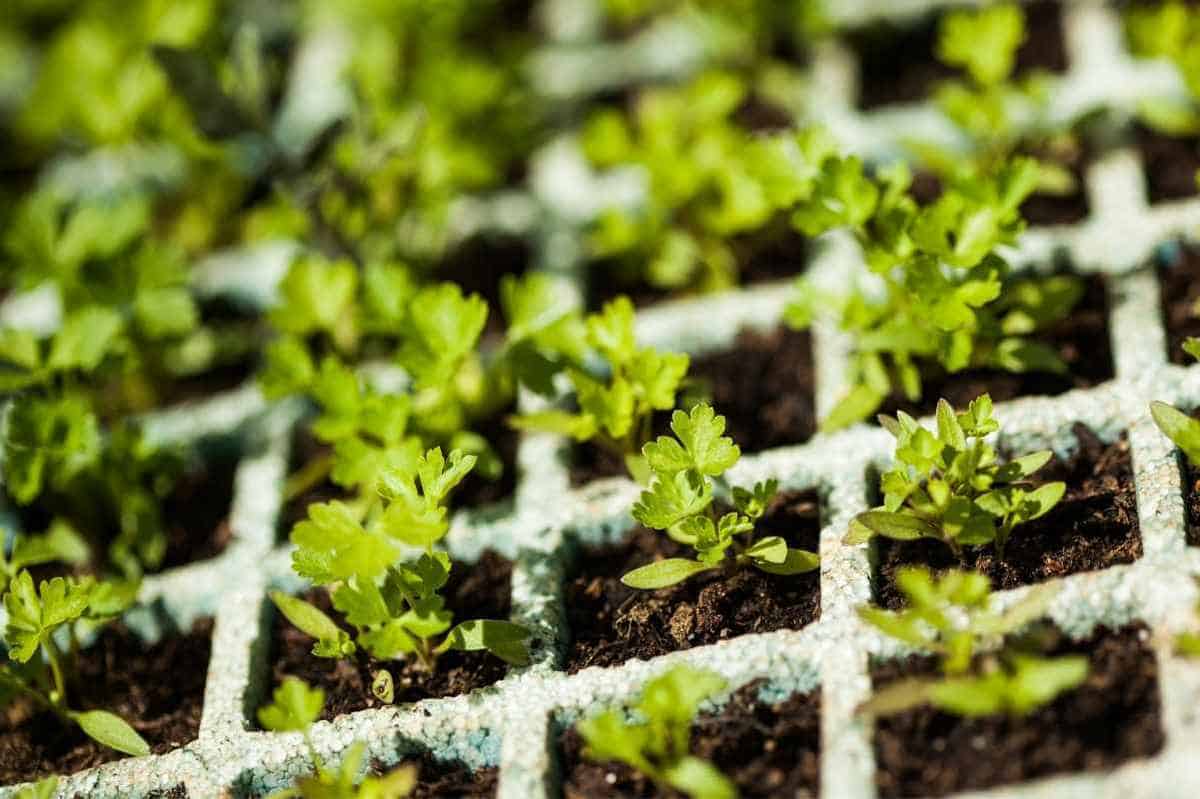
How do I plant parsley?
Parsley should be planted in rich, loamy, well-draining soil. Amend the soil with compost before planting to give parsley a good start. Parsley prefers slightly acidic soil but is flexible enough to grow in a wide range of soil types.
Growfully Protip
Parsley does well in full sun, but benefits from partial shade in particularly hot climates.
Plant parsley seeds 1/4″ deep, firming the soil well over top. If direct sowing parsley, sow seeds six to ten inches apart.
Because of the sporadic germination of parsley seeds, we recommend sowing thickly and keeping the soil or seed starting mix warm and moist until germination, which may take up to one month. Indoors, you can help keep their environment warm and humid with a humidity dome or plastic wrap.
Growfully Protip
Like all seeds in the carrot family, parsley plants are pretty sporadic with their germination, so make sure to plant thickly and be patient—it might take two weeks or more before any seedlings emerge.
Thin seedlings to one seedling per spot once the parsley has at least one set of true leaves.
Parsley plants have a tap root that you must be careful to not disturb when transplanting, and it is best to transplant parsley when the seedlings are still small. To transplant, dig a hole wide enough for the seedling, gently remove the plant, and then place it in the hole. Fill in the soil around the seedlings, tamp down with your hands, and water well.

Download Printable Parsley Growing Guide »
How do you care for parsley?
Lightly mulch around parsley plants to retain moisture and prevent weeds. Parsley won’t need much fertilizer in rich soil amended with compost. If your parsley looks a little pale, you can use a foliar nitrogen-rich liquid fertilizer like fish emulsion to make the parsley greener and lusher.
Parsley is relatively low maintenance, as long as you remember that herbs want to be harvested. The more you harvest parsley, the more it will produce.
How long does it take to grow parsley?
Once the right weather conditions hit in early spring, parsley is fast growing—even faster when you regularly harvest from the plant. You can start harvesting from the plant as soon as the leaves are large enough to use. Just make sure to never harvest more than 50% of the plant on large plants and 30% on newer, younger plants. We typically start harvesting within 4-6 weeks of planting out in the garden.

How long does a parsley plant last?
Many gardeners grow parsley as an annual because the first year is when the leaves are flavorful and tender. However, if you let the plants stick around to the second year, you’ll still have some stems and leaves to harvest, but most importantly, you’ll be supporting pollinators and beneficial insects as the parsley will bolt and then flower in its second season.
Parsley is very hardy. Unless you have particularly cold winters, the plants can be left uncovered in the garden to give you fresh parsley all winter.
What grows well with parsley?
Parsley makes a great companion plant for many vegetables and herbs because it both supports pollinators and attracts beneficial insects to the garden. Plant it with carrots, chives, corn, onions, peas, peppers, tomatoes, sage, and thyme for the best results.

Does parsley grow well indoors?
Parsley is a good candidate for an indoor herb garden with one caveat—because of its intense tap root in full-size plants, you’ll need a large, deep container. We’ve seen many store-bought herb gardens try to sell parsley plants in small pots, but we promise you won’t get much parsley that way! Instead, put a single parsley plant in a pot that is at least 10″ deep (and deeper is even better) for the best parsley production.
How do you harvest parsley?
Harvesting parsley is simple—just snip off what you need, and your parsley plant will grow bigger and stronger! For the most vigorous growth, we recommend only harvesting what you need at the time. If you harvest more than a third of your plant at a time, it will take some time to grow back.
Growfully Protip
Our favorite way to store harvested parsley and other lush, green herbs: like a bouquet of flowers in a jar of water! We keep this edible arrangement on the counter, but you can stretch the life even more by covering the bouquet loosely with an open zip-top bag and then placing it in the refrigerator.
Does parsley come back every year?
In more mild climates, parsley may be grown as a biennial plant, meaning it lives for two years. The parsley in the first year will be the most tender and delicious. In the second year, the plant will put out flowers and eventually produce seeds. If you have the climate and space for it, we recommend letting parsley go through its entire two-year lifecycle to attract beneficial insects and pollinators like bees and butterflies.
Here in zone 6B, we plant parsley in the spring, harvest it through the entire growing season, and then let it go to seed the next year to save parsley seeds for future plantings. We plant new parsley plants each year since the second year parsley tends to be tough and bitter once they start to flower.
Download Printable Parsley Growing Guide »
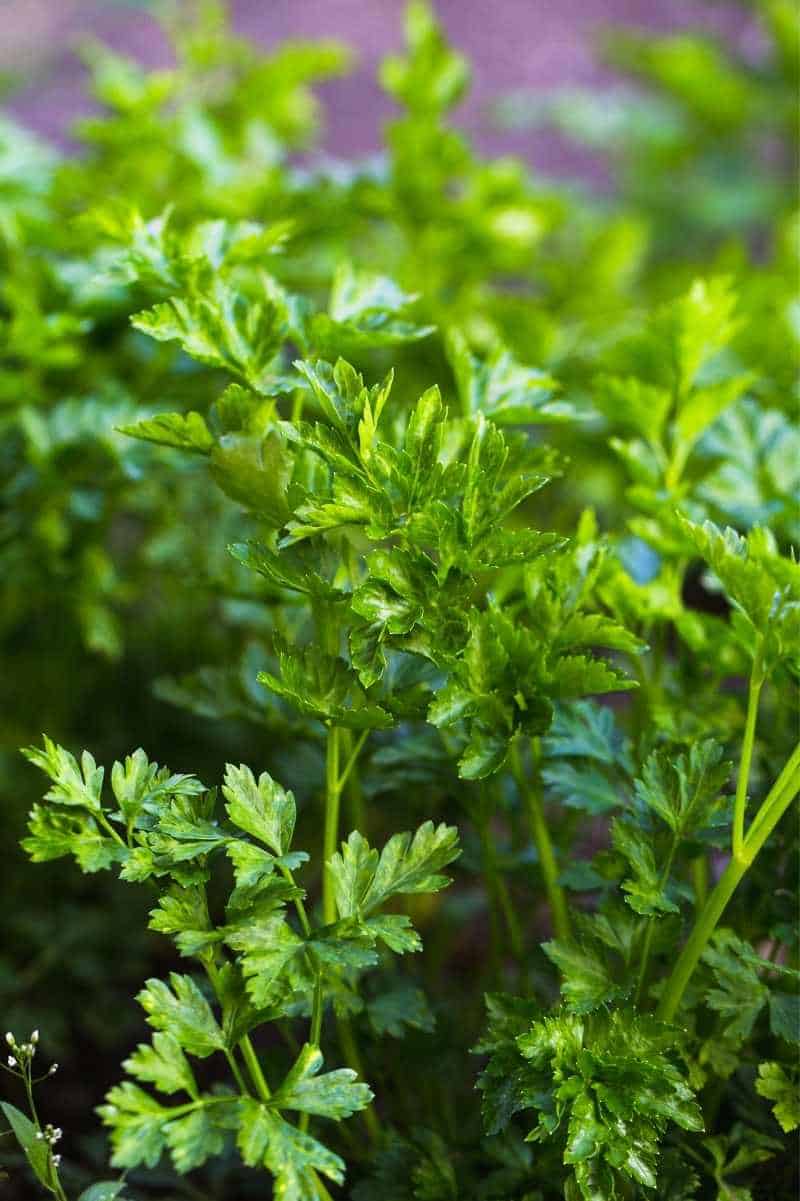
How to Grow Parsley
Materials
- Parsley seeds or transplants
Tools
- Balanced or nitrogen-leading fertilizer
Instructions

- Let there be light. Parsley likes full sun but will thrive if given some light afternoon shade in hot climates.
- Give it nitrogen. With rich soil, fertilizing parsley isn't necessary. But if you need to feed your herbs, a balanced or nitrogen-leading fertilizer is a good option for keeping parsley happy.
- Cool weather preferred. Parsley enjoys some light shade in the heat of the afternoon and will grow the most robustly during the cool temperatures of spring and fall.
- Use those herbs! Like most herb plants, parsley loves to be pruned and used. Frequent clipping of parsley leaves and stems makes for a robust, bushier plant.
- Keep the plants. Parsley is a biennial, meaning it completes its life cycle in two years. This makes parsley winter hardy in many growing zones. When the cold nips the plant in the winter, don't pull it! The plant will regrow in the spring, bolt, and flower to complete its life-cycle. Flowering parsley is a huge attraction for beneficial insects in your garden.
- Use it for companion planting. Parsley is a good companion for most plants throughout the garden. Plant it wherever you have an open spot. If you have struggled with pest infestations on other members of the carrot family (carrots, cilantro, parsnips, etc) in the past, avoid planting those same plants with parsley.

